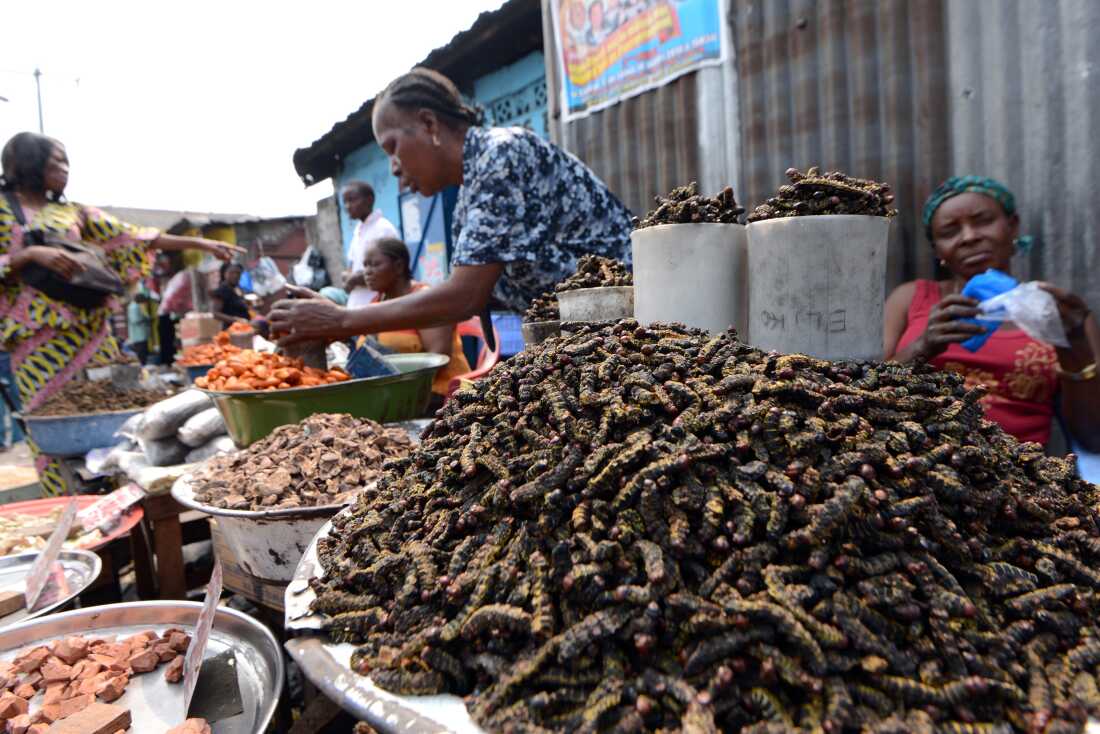A vendor holds huge weevil larvae at Kinshasa’s Gambela market. At Gambela market, folks can discover bugs for all tastes : huge weevil larvae leaving a smoothness feeling within the mouth, barely crunchy caterpillars or termites cracking between your enamel
Junior D. Kanna/AFP by way of Getty Pictures
cover caption
toggle caption
Junior D. Kanna/AFP by way of Getty Pictures
KINSHASA, Democratic Republic of Congo — They’re tastier than they give the impression of being. Edible bugs within the type of wriggling maggots or furry caterpillars are each delicacy and staple within the Democratic Republic of Congo (DRC), a central African nation of practically 120 million folks.
In markets within the capital Kinshasa, tubs stuffed with writhing white maggots line the alleyways, and girls merchants fry caterpillars, spiced with chili, over charcoal fires. “The more you eat caterpillars, the more you’ll have a long life,” says Trésor Kisanbu, clutching a small plastic bag of fried caterpillars, in Kinshasa’s largest market, Marché Liberté. “It strengthens your muscles and your eyes, it’s really organic,” he provides.
Villagers harvest contemporary caterpillars and maggots from rotting tree trunks in forested areas within the Congolese inside. From there, they’re despatched by the boatload down the Congo River — the second-largest in Africa — on the market in Kinshasa’s markets.
“People eat a lot of them,” says Mamman Coco, who runs a stall overflowing with piles of maize flour, dried beans and edible bugs, within the heart of Kinshasa’s sprawling central market.
She factors to the caterpillars’ excessive protein and vitamin content material as promoting factors, and the truth that they’re natural.

Crunchy caterpillars on sale in a market in Kinshasa.
JUNIOR D. KANNAH/AFP
cover caption
toggle caption
JUNIOR D. KANNAH/AFP
To style, the caterpillars are earthy and bitter. Often called Mbinzo, in Kinshasa’s dominant language Lingala, the caterpillars are from a species of emperor moth.
They’re an costly delicacy at about $200 a kilo, an infinite sum in a grindingly poor nation the place, in keeping with the World Financial institution, two thirds of the inhabitants survive on beneath $2 a day.
Mpose is extra in style fare. That is the Lingala time period for the larvae of palm weevils, a kind of beetle that lives in palm bushes. They are often eaten with rice or fufu, a starchy staple, or as a crispy fried snack.
The larvae are principally imported from rural areas too, however they are often raised commercially.
Congolese NGO Farms For Orphans raises Mpose maggots by the hundreds to distribute to orphanages in Kinshasa, but it surely additionally sells its produce to market merchants and Congolese émigrés nostalgic for a style of dwelling.
“In the DRC, meat products aren’t available to everyone,” explains Françoise Lukadi, the president of Farms for Orphans, due to their excessive value. “If you buy very small quantities of insects, you gain more nutritional value than if you buy the same quantities of meat,” she says.
Consuming bugs is conventional in lots of components of Congo. Nevertheless, the apply is not widespread in all components of the nation. An enormous state roughly the dimensions of continental western Europe, Congo is awfully various, with over 200 completely different ethnic teams and as many spoken languages.

An individual eats grilled caterpillars with olive oil in a makeshift restaurant within the Lingwala district of Kinshasa.
JUNIOR D. KANNAH/AFP
cover caption
toggle caption
JUNIOR D. KANNAH/AFP
Some analysis means that insect consumption has elevated in latest a long time. A 2023 examine revealed within the journal Bois et Forêts des Tropiques discovered that within the Luki biosphere reserve about 250 miles southwest of Kinshasa, in western Congo, villagers solely started to eat bugs within the late Nineteen Seventies.
In line with the lead researcher Ernestine Lonpi Tipi, that interval coincided with drought and the gradual degradation of forests, and subsequent shortage of bushmeat. Then, back-to-back civil wars within the Nineties and 2000s cratered the financial system.
Lonpi Tipi added that domesticating larvae manufacturing in the end would result in fixing issues associated to entry to protein- and nutrition-rich meals.
Françoise Lukadi of Farms for Orphans agrees. In a low rectangular constructing in Kinshasa’s principal college, cabinets are stacked with plastic tubs of palm weevils. Staff clear out the tubs and add in new meals for the maggots: items of palm bark and natural waste from beer manufacturing.
Farms for Orphans produces about 300 kilos of maggots a month and it is trying to broaden manufacturing.
“They’re very good to eat,” Lukadi mentioned, however she admitted that even in Congo, the place folks eat bugs commonly, many are nonetheless squeamish.




